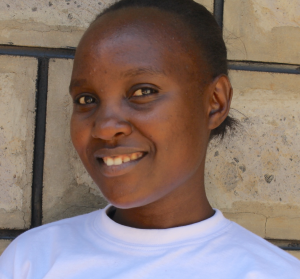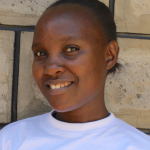We left for our visit to Chebunaywa Secondary School on a sunny morning, but the sky later clouded over. Chebunaywa Secondary is located in Lusengeli, which is known for its cold temperatures because of the nearby Kaimosi Forest.
Chebunaywa Village is a very quiet and peaceful place. We saw everyone minding their own business on their farms and the children helping clean around their homes and fetching water for their family cows. The place is very rocky with a steep topography.
We learned that the school opened in 2010. A member of parliament put up all of the structures in the school by using community development funds. The school started with poor performance because the board of management could only afford under-qualified staff. As per now, the school has trained teachers and they are hoping that this year they will send at least one student to university.
The school struggles because though enrollment has grown to 289 students, they do not have clean, reliable water. There is one 10,000-liter plastic tank that was donated by the nearby church, but this is still nowhere near enough water for students to drink, the school cook to make meal, or for the latrines and classrooms to remain clean.
"My worries have been a driving force and this made me approach our [church] sponsors who donated the plastic tank. This tank reduced our problems but it has not solved it," said Principal Geoffrey Mmaitsi.
"I have been a very worried principal. I worry about the safety of my students every time they are sent to the spring to fetch water and I often make the teachers on duty to accompany them to the spring."
The spring students have to go to is 300 meters away. We enjoyed going down the spring with the students, but the uphill climb on our way back was very tedious. The spring is literally "water from a rock." There is a huge rock at the eye of the spring and this makes it difficult for the students to reach the farthest end where the water is clearer.
The spring is seasonal with a low yield. There are always conflicts arising between the students and community members due to competition for the limited resource. One neighbor even threatened to restrict the students from passing through his farm, but the church elders talked to him and he cooled his rage.
The students usually return to class already tired from fetching water at the spring. This reduces their concentration in class and some students end up getting too discouraged to attend class altogether.
What we can do:
Training
"I could affirm to you that none of my students wash their hands after toilet visits. We are looking forward to this project and all he benefits that come alone with it like hygiene and sanitation training," said Principal Mmaitsi.
Training on good hygiene habits will be held for two days. The facilitator will use PHAST (participatory hygiene and sanitation transformation), ABCD (asset-based community development), CTC (child to child), lectures, group discussions, and handouts to teach health topics and ways to promote good practices within the school. The CTC method will prepare students to lead other students into healthy habits, as well as kickstart a CTC club for the school.
Handwashing Stations
We will deliver two handwashing stations to the school, and the club will fill them with water on a daily basis and make sure there is always a cleaning agent such as soap or ash.
VIP Latrines
"This school has very poor hygiene and sanitation practices as well as facilities. We condemned the four latrines that were used by boys and we had to allocate them some four latrines that belonged to the girls. This has led to congestion at the latrines during break time and the latrines end up being dirty and smelly due to overuse," admitted Mr. Mmaitsi.
The latrines are cleaned haphazardly because the students just pour plain water on the floors without scrubbing them. The latrines are near the kitchen where water is kept, but the students are never allowed to use water from the kitchen to clean the latrines.
Two triple-door latrines will be constructed with local materials that the school will help gather. Three doors will serve the girls while the other three serve the boys. And with a new source of water on school grounds, students and staff should have enough to keep these new latrines clean.
Rainwater Catchment Tank
A 50,000-liter rainwater catchment tank will help alleviate the water crisis at this school. The school will also help gather the needed materials such as sand, rocks, and water for mixing cement. Once finished, this tank can begin catching rainfall that will be used by the school’s students and staff.
We and the school strongly believe that with this assistance, standards will significantly improve. These higher standards will translate to better academic performance!

 Rainwater Catchment
Rainwater Catchment
 Rehabilitation Project
Rehabilitation Project


































